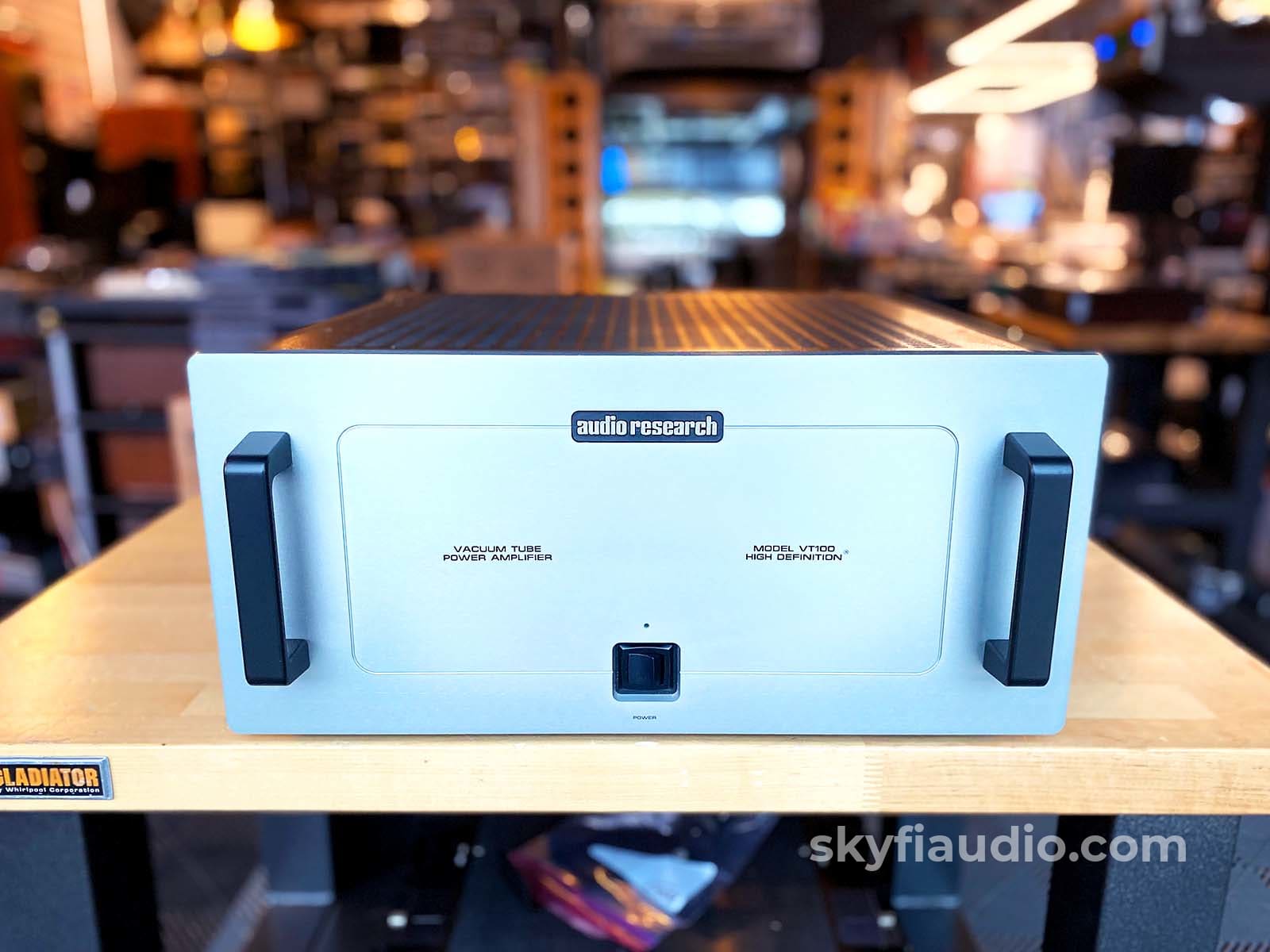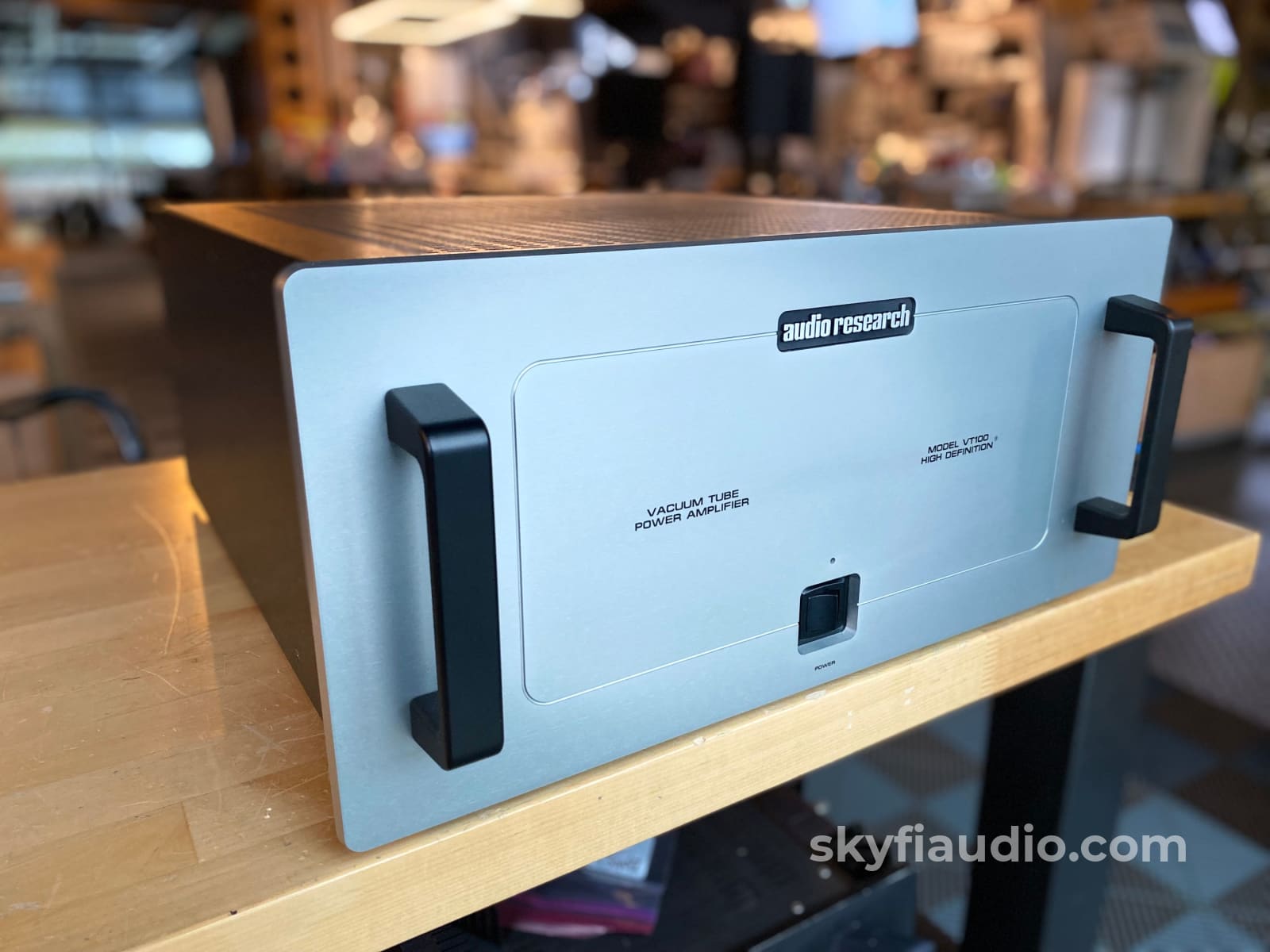










Audio Research VT100 MKII Vintage Tube Amplifier - Serviced
Free Shipping on Most Electronics - Excludes Speakers and Items Requiring Freight - Contiguous U.S. Only
Pickup currently unavailable at SkyFi 479

Audio Research VT100 MKII Vintage Tube Amplifier - Serviced
SkyFi 479
479 South Broad Street
Glen Rock NJ 07452
United States
General:
Please see our VT100 video review below for full design and construction details.
This VT100 is finished in classic ARC silver and is the later MKII version featuring active cooling and a larger power supply.
All VT100's can be converted to native 220V if you have the knowledge. Please let us know when ordering if you'd like it reconfigured.
This VT100 arrived in need of the typical TLC. We replaced several plate screen resistors and re-tubed the unit.
SkyFi Service Notes:
• Select blown screen and plate resistors replaced with official ARC parts.
• Front-end circuitry carefully aligned to official ARC service manual spec for optimal performance.
• Bias adjusted.
SkyFi Tube Notes:
• All driver tubes replaced with new production matched and balanced Russian 6922
• Output tubes replaced with two strong used matched quads of Svetlana 6550 Winged C from our stock. We use a modern and professional Amplitrex tube tester in our shop.
Brand Background:
Audio Research continues its dedication to unparalleled musical expression and crafting components of the highest quality and lasting value for its customers.
Our long-term dedication to service is peerless in this industry (Audio Research, with few exceptions, can repair anything ever produced during its entire history). We continue to seek out new and exciting ways to make music more real and more enjoyable.
More than just a name or a marketing tool, Audio Research has come to represent exceptional performance and long-term value. Experience Audio Research – experience High Definition®.
Ownership:
Single Owner
Connections:
XLR and RCA inputs. Speaker outputs with dedicated taps per ohm (0/4/8)
General Sound:
Smooth, uncolored, undistorted natural and clean
Cosmetic Condition:
7 - Some Wear and Light Scratches
https://skyfiaudio.com/pages/our-rating-scale
Working Condition:
Working perfectly and tested in our lab.
Included:
Amplifier as pictured and a power cord.
Packing:
Original Manufacturers Packing
Original MSRP:
$4,999.00
Dimensions:
19" (483mm) W by 8.75" (222mm) H by 19.5" (495mm) D. Handles extend 1.5" (38mm) forward.
Weight:
67.4 lbs.
Age:
1999
Link to Manual:
https://audioresearch.com/wp-content/uploads/2021/08/VT100II_Manual.pdf
Recommended Cables:
Kimber Kable - RCA Interconnects - Better
Kimber Kable - RCA Interconnects - Best
Kimber Kable - BALANCED XLR Connectors - Better
Kimber Kable - BALANCED XLR Connectors - Best
Kimber Kable - Speaker Cables - Better
Kimber Summit Series Monocle XL Speaker Cables (PAIR) - Best
Kimber Summit Series BiFocal XL Bi-Wire Speaker Cables (PAIR) - Best If Applicable
Kimber Kable - Power Cords - Better
Testing Process:
We start with a visual inspection of all internal components to make sure that there are no signs of heat stress or damage. Capacitors are checked for telltale signs of predictive failure including bulging, shrunken wrappers, or physical leakage. We also inspect resistors and other passive components for signs of overheating. If tube arcing has occurred in the past we can usually spot discoloration on the output tube sockets. On vintage units we often spot check select capacitors for value and ESR.
If the amplifier passes visual inspection, we move on to a full test of all of the tubes. We use an Amplitrex AT-1000 Tube Tester which is capable of testing both emission and Gm with a high degree of accuracy. We document the results of each tube and replace any weak or suspect tubes before proceeding. When we power on tube amplifiers for the first time we usually use a variac and current limited AC supply and slowly raise the voltage up to nominal mains level while monitoring plate, screen, filament, and negative bias supply voltages where applicable. If everything is in order we feed a low level test signal into the amplifier’s input and monitor its output on an oscilloscope across an 8 ohm dummy load. At this point we are just looking to verify basic function and confirm that the output transformers are not damaged. Once we have verified that the amplifier is safe to operate, we connected it to full mains power. For fixed bias amps we set the bias to manufacturer spec. For cathode biased amps we monitor the plate to cathode voltage to determine if the output tubes are operating in a safe range. Once the output section is verified we move onto bench evaluation.
We start by feeding the input of the amplifier with a low level 1KHz test signal, slowly increase its amplitude while monitoring the amplifier’s output on an oscilloscope for signs of noise, clipping, distortion, or improper channel balance. We continue increasing the signal level until the amplifier reaches clipping. At this point we take an output power measurement and compare it to the spec sheet of the amplifier to verify proper performance. We finish off the bench evaluation with a 1KHz square wave check and a 20Hz to 20KHz sine sweep to assess the amplifier’s frequency response characteristics. This battery of tests will usually reveal if the amplifier has any issues that need further attention.
Before the device leaves the bench, we perform a listening test with actual music using a variety of preferred test tracks. Our benches are outfitted with familiar monitor speakers which help us identify inconsistencies that will not always show up on our test gear. The main things that we are listening for are hum or noise with no signal present, proper center image, clicks, pops, or any other obvious undesirable audio characteristics.
If the unit passes all of these tests it is moved to our long term testing rig where we simulate real word operating conditions for 6-8 hours. For tube amps we like to run this test at least twice. This allows us to monitor the unit for signs of thermal runaway or intermittent issues that only crop up when it has fully come up to temperature. We find this step to be essential, especially for vintage units.
Specs:
Stereo tubed power amplifier with balanced inputs and 4, 8, and 16 ohm output transformer taps.
Tube complement: 4 matched pairs of 6550C output tubes, 4 6H30 driver tubes.
Maximum output power: 110Wpc continuous, 20Hz–20kHz at 1kHz with THD typically 0.3% at 110W, 0.03% at 1W; 120W at clipping (20.8dBW).
Frequency response: 0.6Hz–90kHz, –3dB.
Input sensitivity: 1.8V RMS balanced for rated output (24dB balanced gain into 8 ohms).
Input impedance: 300k ohms balanced.
Output polarity: non-inverting.
Damping factor: approximately 12.
Hum & noise: 0.2mV RMS, 106dB below rated output (IHF weighted, input shorted).
Power requirements: 105–125VAC, 60Hz (210–250VAC, 50Hz), 630W at rated output, 800W maximum, 410W at "idle."
Dimensions: 19" (483mm) W by 8.75" (222mm) H by 19.5" (495mm) D. Handles extend 1.5" (38mm) forward.
Weight: 67.4 lbs (30.7kg) net, 83 lbs (37.8kg) shipping.
Choose options











